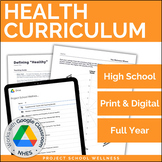Food and Nutrition - How to Eat Healthy, High School Health Lesson Plan
- PDF
- Google Apps™

Also included in
- In these physical health unit plans, students will examine a holistic and empowering definition of physical health (moving beyond eating and exercising for the purpose of looking a certain way). In this unit, students will examine four core body care elements (sleep, movement, hygiene, and nourishmePrice $45.00Original Price $72.50Save $27.50
- Immerse your high school students in a transformative health and wellness journey with our comprehensive, skills-based health curriculum. Designed as a fully prepared, done-for-you program, this high school health and wellness curriculum focuses on cultivating core health skills that seamlessly intePrice $525.00Original Price $776.50Save $251.50
Description
This physical health lesson plan expands upon the typical conversations we have about food (i.e. calories in vs. calories out, restrictive diets, good vs. bad foods, etc). The goal is for students to recognize the critical role food and water play in caring for their bodies. The concepts of this lesson lay a foundation for the next where students will analyze what it means to have a healthy relationship with food.
***This done-for-you lesson plan is ready for digital, in-person, or hybrid learning!***
Your Students Will
- Classified macronutrients and micronutrients characteristics.
- Calculate the amount of water they should drink each day.
- Distinguish how food nourishes mental, physical, and social health.
National Health Education Standards met in this lesson:
- 1.12.1 Predict how healthy behaviors can affect health status.
- 1.12.2 Describe the interrelationships of emotional, intellectual, physical, and social health.
- 7.12.2 Demonstrate a variety of healthy practices and behaviors that will maintain or improve the health of self and others.
This Done-For-You lesson plan comes with:
- Instruction Video - Watch the provided teaching videos to help you navigate the complexities of mental health with confidence, comfort, and clarity.
- Teaching Guide - A detailed lesson plan requiring minimal prep and NO extra planning
- Editable Teaching PowerPoints
- Grading Rubrics - For quick and meaningful assessments
- Free updates for life!
>>> Need more high school skills-based lesson plans? - Check out our High School Curriculum
Distance Learning Compatible
This resource is hosted on Google Drive and can easily be transferred to your Google Classroom. If applicable, this resource features a Google Slides edition of the student worksheet and a Google Forms version of the learning station activity. Learn how on our blog!
Looking For More
- Free skills-based health lesson plans - Download Now!
- Free skills-based health workshop - Sign Up Here!
- Skills-Based Health Educators Facebook Group - Join!
- Health education resources and ideas - Check it out!
Google Drive Disclaimer
Upon purchase, you’ll receive a link to access your resource on Google Drive. Using Google Drive is the easiest way for us to edit and update resources. This allows us to quickly respond to feedback, share new features, and make sure this product is serving you well! If you have any issues with this, please email janelle@projectschoolwellness.com for assistance.







